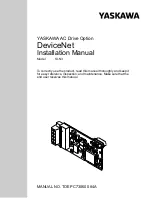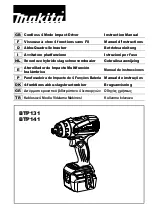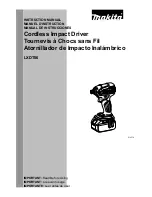
SAFETY INSTRUCTIONS
Read these instructions before using the tool.
Keep the instruction manual for future reference.
WARNING:
Failure to observe the user instructions and safety precautions may result in the risk of an electric shock
or fire and/or serious injury.
Working space
• Keep your working space clean and well lit. Dark and cluttered areas increase the risk of accidents and injuries.
• Do not use power tools in explosive environments such as around flammable liquids, gases and dust. Power tools
produce sparks that can ignite dust or vapours.
• Keep children and onlookers safely away from the work area where you use power tools. If your attention is
distracted, you can easily lose control of the tool you are working with.
Electrical safety
• The power plug cable must be compatible with the power grid socket. Never modify the plug in any way. Never use
a socket adapter with earthed tools. Stock (unmodified) plugs and sockets reduce the risk of electric shock.
• Avoid any contact between your body and earthed surfaces such as piping, radiators, stoves and refrigerators.
If your body is earthed, you face an increased risk of electric shock.
• Do not expose power tools to rain or moisture. Water inside a power tools increases the risk of electric shock.
• Handle the power cable carefully. Never use the power cable for carrying the tool hanging on the table, do not
pull the tool by the cable, do not unplug the cable by pulling on the cable. Do not expose the power cable to
heat or oils; protect it from sharp edges and moving parts. Damaged and tangled power cable increases the risk
of electric shock.
• We recommend using a residual current device (RCD) with maximum residual current of 30 mA. When using this
tool outdoors, use only an extension power cable approved for outdoor use. Power cables rated for outdoor use
reduce the risk of electric shock.
• If it is absolutely inevitable to use the tool in a moist environment, use power mains protected by a residual current
device (RCD). The use of RCD reduces the risk of electric shock.
Safety of persons at work
• Be attentive. Pay attention to what you do and use common sense when working with power tools. Never use
power tools if you are tired or under the influence of drugs, alcohol or medication. A moment of inattentiveness
when working with a power tool may cause a serious injury.
• Use personal protective items. Wear eye protection. Depending on the type of tool and working method, use
protective items such as respirator, non-slip working shoes, helmet, and ear protection in order to reduce the risk
of damaging your health.
• Avoid unintentional starting of the tool. Before plugging in or lifting or carrying the tool, make sure the switch is in
the OFF position. Carrying a power tool with a finger on the switch or with power cable plugged in the socket with
the switch in the ON position increases the risk of accident and injury.
• Prior to starting the power tool, remove any adjusting keys and wrenches. Adjusting wrenches and similar tools left
in the rotating part of the tool can cause injuries.
• Do not overreach. When working, keep proper footing and balance at all times. This ensures you retaining control
over the tool even in unexpected situations.
• Dress properly. Do not wear loose clothing or jewellery. Keep your hair, clothing and gloves out of reach of the
moving parts of the tool. Loose clothes, jewellery and long hair can be caught by the moving parts of the tool.
• If a dust extraction and capture device is available, it should be attached to the tool and used properly. You can
reduce the risk of dust issues by using the device.
Use and maintenance
• Do not force the power tool. Use the right tool for the planned job. The tool will do the job better and safer if used
at the rate for which it was designed.
• If the tool cannot be switched on or off using its electrical switch, do not use it. Power tools that cannot be
controlled using the switch are hazardous and need repair.




































